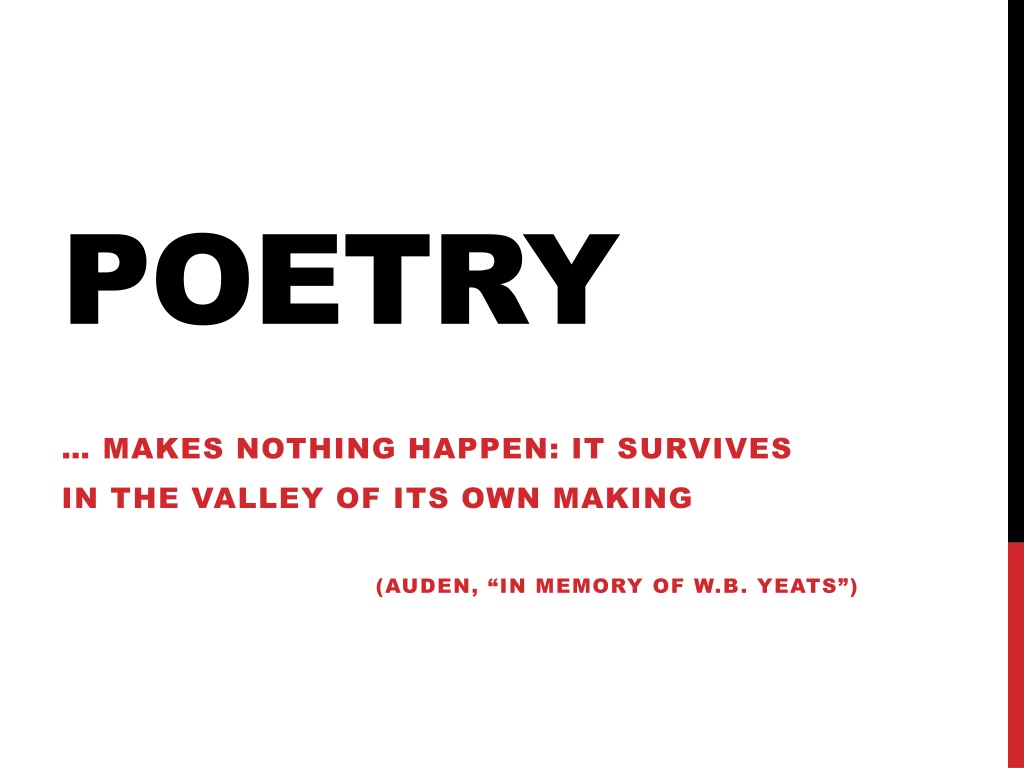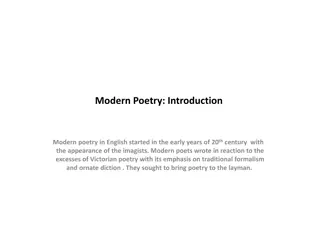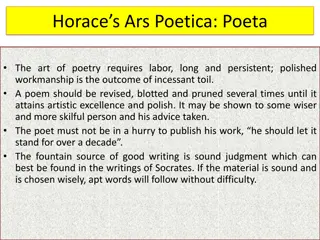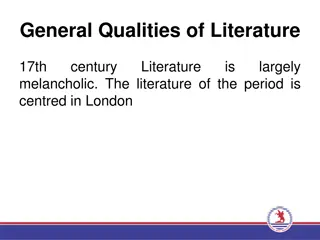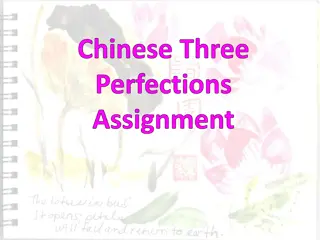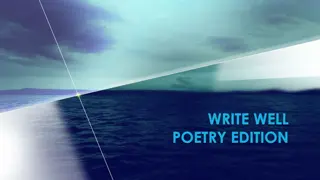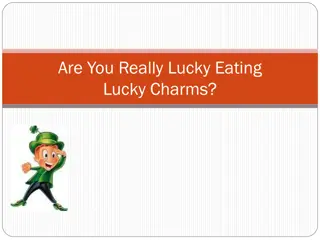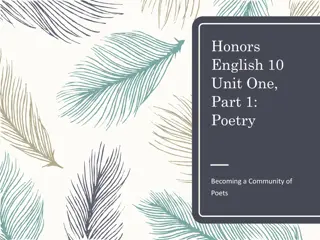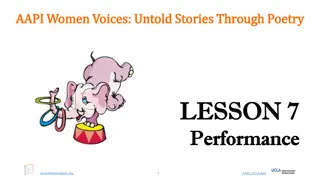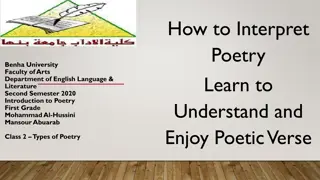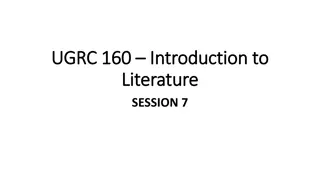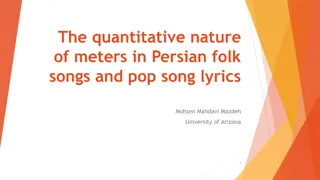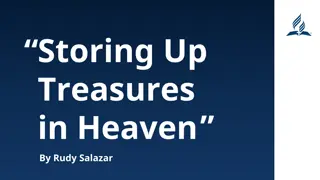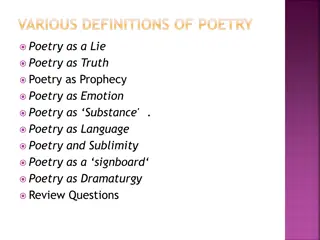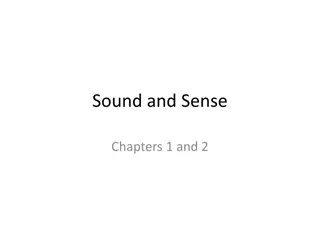Uncovering Poetry's Treasures
Delve into the intricate process of TP-CASTT, a method to unveil the layers of meaning in well-crafted poems. Discover the profound significance of understanding poetry, as it reflects the essence of life and evokes deep emotions in its readers. Explore the reasons why dissecting poetry is a rewarding endeavor through the insights of renowned poets and scholars.
Download Presentation

Please find below an Image/Link to download the presentation.
The content on the website is provided AS IS for your information and personal use only. It may not be sold, licensed, or shared on other websites without obtaining consent from the author.If you encounter any issues during the download, it is possible that the publisher has removed the file from their server.
You are allowed to download the files provided on this website for personal or commercial use, subject to the condition that they are used lawfully. All files are the property of their respective owners.
The content on the website is provided AS IS for your information and personal use only. It may not be sold, licensed, or shared on other websites without obtaining consent from the author.
E N D
Presentation Transcript
POETRY MAKES NOTHING HAPPEN: IT SURVIVES IN THE VALLEY OF ITS OWN MAKING (AUDEN, IN MEMORY OF W.B. YEATS )
Cambridge English Practical Criticism Paper (2014): Tipp-Ex Sonate
WHAT COULD BE SAID? A better strategy would be to put Tipp-Ex Sonate in a wider aesthetic context. Students could discuss the avant-garde tradition of anti-art Alternatively, a student could discuss the likes of EE Cummings, Charles Olson and Ezra Pound, all of whom used typographic trickery in their poems. [ ] It's also possible to see it as a memorial to the millions who died as a result of the last century's wars and despotisms - "a commemoration of the disappeared and the inadequacy of language", suggests Ford. In fact, according to Kombuis, a long-standing anti-apartheid activist, Tipp-Ex-Sonate was a protest against censorship laws imposed during white minority rule. "If you know about the historical and political context you could make sense of it as an inability to use a language that's tainted by apartheid," says Ford. [ ] Some students must surely have been tempted to hand back their exam papers adorned only with punctuation of their own. (BBC)
HOW IS POETRY SCULPTED? I wish our clever young poets would remember my homely definitions of prose and poetry; that is, prose, words in their best order; poetry, the best words in their best order. Samuel Taylor Coleridge
HOW DO I ANALYSE POETRY? 1. Subject-matter: what is the poem about? Structure: what structural features are notable? Rhythm: how are the lines paced and stressed? Rhyme and other sound patterns 2. 3. 4.
INDIVIDUAL AND SOCIETY Unseen text will definitely contain I&S themes; foreground these themes through your analyses (particularly in topic sentences)
HISTORY SUBJECT MATTER On the surface A schoolmaster leading his pupils through war-torn Warsaw. Related issues? Loss, destruction, dehumanisation (as a result of war), chaos
HISTORY STRUCTURE Immediate observation of linguistic structure: one long sentence. Effect? - Prolonged action: The schoolmaster ok, what does he do?!?! lead[s] his twelve-year-olds - This simple act, stated in one sentence, but presented as a poem, is thus charged with significance and emerges as an act containing several other acts.
HISTORY STRUCTURE Poetic form: free verse - Disconcerting? - The freedom of movement in this poetic form is limited by the fact that the poem is a sentence that marches towards its inevitable conclusion (// characters who march towards their inevitable deaths?) - Deterministic?
HISTORY RHYTHM Enjambment and caesura: slowing the progression/pace of the poem effect? - Commentary on the characters pacing through Warsaw: halting, interrupted, disorderly
HISTORY RHYME Absence of distinctive rhyme scheme - Disharmony, discord - Invitation to listen to other sound patterns in the poem.
HISTORY SOUND PATTERNS Poetic imagery of loss/destruction carpet slippers treading rubble of smashed cellars, [ ] glare of the burning street
HISTORY LANGUAGE Metonymy Enumeration of loss: - bi-focals , pipe , tree-shaded study and his wife Charlotte effect? - Why this list? - What is lost?
WHAT IS THE POEM ABOUT ? 1. About the futility of resistance, 2. About despair in the face of this futility 3. About the fragility of humanity in the face of violence 4. A poem about the dehumanising force of war 5. About understated heroism 6. About the transformation of determinism to determination
Dietrich Bonhoeffer 4 Feb 1906 9 Apr 1945
CHRISTMAS TREES CHRISTMAS TREES BY BY GEOFFREY HILL GEOFFREY HILL Subject Matter?
CHRISTMAS TREES RHYME - Three tercets; rhyme scheme: A1 A2 A1 B1 B1 B2 C1 C2 C1 effect? Clue: containment; resistance of containment
CHRISTMAS TREES RHYTHM - Regularity of syllables: 8 syllables per line, except for one effect? - Some regularity of feet effect?
CHRISTMAS TREES STRUCTURE - More end-stopped lines than enjambment effect?
CHRISTMAS TREES STRUCTURE Structure invites interpretation - Stanza 1 s rhyme associates cell with citadel metamorphosis and resistance - End-stopped lines suggest self-contained units imprisonment or completeness? - quiet ironically stands out in line 8 what do we hear? We hear too late or not too late
CHRISTMAS TREES LANGUAGE Ambivalence in language - sacrifice : for the anti-Nazi or Nazi cause? Or both? - Lines 8-9: deliberately evasive? Ambivalence resists the state s ability to fix the individual to a particular identity.
WHAT IS THIS POEM ABOUT ? 1. About an individual s resistance / subversion of the state s power to signify / contain) 2. About the transformative power of Bonhoeffer s sacrifice 3. About establishing order from chaos, turning discord into harmony
Individual and Society?
OTHELLO (2.1.179-287) It gives me wonder great as my content To see you here before me. O my soul s joy! If after every tempest come such calms, May the winds blow till they have wakened death And let the labouring bark climb hills of seas Olympus-high, and duck again as low As hell s from heaven. If it were now to die, Twere now to be most happy; for I fear My soul hath her content so absolute That not another comfort like to this Succeeds in unknown fate.
OTHELLO (2.1.179-287) It gives me wonder great as my content note meter and stress p. To see you here before me. O my soul s joy! note change in stress p. If after every tempest come such calms, May the winds blow till they have wakened death note pace & stress p. And let the labouring bark climb hills of seas__ Olympus-high, and duck again as low As hell s from heaven. If it were now to die, _ Twere now to be most happy; for I fear note change in stress p. My soul hath her content so absolute note change in stress p. That not another comfort like to this Succeeds in unknown fate. note line length and contrast to opening.
